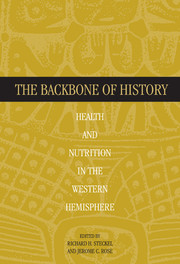Book contents
- Frontmatter
- Contents
- Preface
- List of Contributors
- PART I
- PART II METHODOLOGY
- PART III EURO-AMERICANS AND AFRICAN-AMERICANS IN NORTH AMERICA
- PART IV NATIVE AMERICANS IN CENTRAL AMERICA
- PART V NATIVE AMERICANS AND EURO-AMERICANS IN SOUTH AMERICA
- PART VI NATIVE AMERICANS IN NORTH AMERICA
- Introduction
- 14 A Biohistory of Health and Behavior in the Georgia Bight: The Agricultural Transition and the Impact of European Contact
- 15 Native Americans in Eastern North America: The Southern Great Lakes and Upper Ohio Valley
- 16 Cultural Longevity and Biological Stress in the American Southwest
- 17 Health, Nutrition, and Demographic Change in Native California
- 18 Welfare History on the Great Plains: Mortality and Skeletal Health, 1650 to 1900
- PART VII
- PART VIII
- PART IX EPILOGUE
- Index
16 - Cultural Longevity and Biological Stress in the American Southwest
Published online by Cambridge University Press: 01 March 2010
- Frontmatter
- Contents
- Preface
- List of Contributors
- PART I
- PART II METHODOLOGY
- PART III EURO-AMERICANS AND AFRICAN-AMERICANS IN NORTH AMERICA
- PART IV NATIVE AMERICANS IN CENTRAL AMERICA
- PART V NATIVE AMERICANS AND EURO-AMERICANS IN SOUTH AMERICA
- PART VI NATIVE AMERICANS IN NORTH AMERICA
- Introduction
- 14 A Biohistory of Health and Behavior in the Georgia Bight: The Agricultural Transition and the Impact of European Contact
- 15 Native Americans in Eastern North America: The Southern Great Lakes and Upper Ohio Valley
- 16 Cultural Longevity and Biological Stress in the American Southwest
- 17 Health, Nutrition, and Demographic Change in Native California
- 18 Welfare History on the Great Plains: Mortality and Skeletal Health, 1650 to 1900
- PART VII
- PART VIII
- PART IX EPILOGUE
- Index
Summary
ABSTRACT
A wealth of data exists for the American Southwest on diet, health, settlement, and other aspects of life in the precolonial and colonial periods. TheWestern Hemisphere project provided a way to begin to synthesize these data on a regional and comparative scale. The health index, as the average of the quality-adjusted life-years lived by a group (that is, the combined effects of morbidity and mortality), demonstrates that individuals in the Southwest carried a morbidity burden higher than most of the other areas discussed in this volume. Mortality is high and morbidity is ubiquitous. The combination of these two related processes resulted in a health index score of 16.5/26.4 or 62.5%. The mean age at death of approximately 24 years suggests that Southwest groups were on the lower end of the mortality spectrum. Comparison of comparable data sets provides a dimension of analysis in the Southwest not previously possible, and as such, presents important additional information for the interpretation of health in the American Southwest.
INTRODUCTION
In pre–Columbian times, the Greater Southwest was a biogeographically, culturally, and politically complex area incorporating Arizona, New Mexico, and southern Utah and Colorado in the United States, as well as all the states of northern Mexico, including Chihuahua, Sonora, and Durango. It was then, and continues to be, a cultural, political, and economically diverse area where contact, trade, and boundary maintenance and dispute define local and regional interactions.
The Southwest is also a place where semiarid desert landscapes abound. Water is at a premium, and arable land is a limited resource.
- Type
- Chapter
- Information
- The Backbone of HistoryHealth and Nutrition in the Western Hemisphere, pp. 481 - 505Publisher: Cambridge University PressPrint publication year: 2002
- 12
- Cited by



